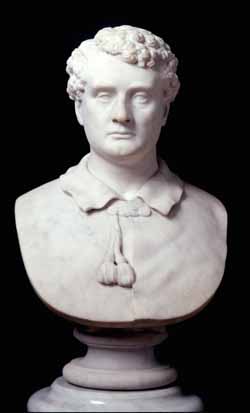Collections Online
John Albion Andrew
To order an image, navigate to the full
display and click "request this image"
on the blue toolbar.
-
Choose an alternate description of this item written for these projects:
- MHS 225th Anniversary
- Main description
[ This description is from the project: Witness to America's Past ]
The great Civil War governor of Massachusetts, John Albion Andrew came to Boston from his native Maine in 1837 to study law in the office of Henry Fuller, who was an uncle of Margaret Fuller. An early and ardent abolitionist, Andrew opposed the Fugitive Slave Law in 1850 and in 1854 represented the defendants indicted at Boston for rescuing the fugitive slave Anthony Burns. He became a leader of the movement when elected to the Massachusetts legislature in 1857, and when John Brown was imprisoned for his raid at Harper's Ferry, Andrew took a leading part in raising funds for Brown's defense. Elected governor of Massachusetts in 1860, he is best remembered for providing the first troops to answer Lincoln's call to arms and for organizing the first Black regiment in the north, the 54th Massachusetts Regiment.1
Governor Andrew was elected to membership in the Historical Society in 1866, and his personal and official papers were donated to the Society by his children. The collection includes a gruesome assortment of slave artifacts—slave whips, part of a slave auction block, and a punishment collar—sent to Andrew by the Massachusetts troops as a reminder of the grim reality of bondage.2 The Society also has a study portrait of Andrew by William Morris Hunt (1867), painted in preparation for the full-size painting at Faneuil Hall.
The sculptor Thomas Ridgeway Gould was a Boston native and began his career as the local representative of a family-run mercantile business based in New Orleans, while during his spare moments he studied sculpting in the studio of Seth Cheney. When the Civil War ruined the family business, Gould turned his amateur interest in sculpting to professional benefit and opened a small studio in Boston. His earliest surviving work is a bust of Ralph Waldo Emerson (1861, Harvard Portrait Collection). This bust of the governor was another of Gould's early works and shows Andrew in a characteristic attitude, without his trademark spectacles but wearing a cape tightly drawn with tassels around his shirt collar. This conservative pose suited Andrew's personality better than a bare-chested or toga-draped representation would. Gould later also created the full-length sculpture of Governor Andrew for his funerary monument in Hingham, Massachusetts. Among his other portrait busts, Gould carved Junius Brutus Booth, the actor and stage manager then living in Boston, and the artist became so interested in his subject that he later wrote a book on Booth's career. Gould moved to Italy in 1868 and, apart from two brief visits home, spent the rest of his life abroad. He is perhaps best known for his nine-foot bronze sculpture of King Kamehameha I, the original of which is near the king's birthplace on the island of Hawaii, while the more famous copy stands in front of the old Judiciary Building in Honolulu.3

